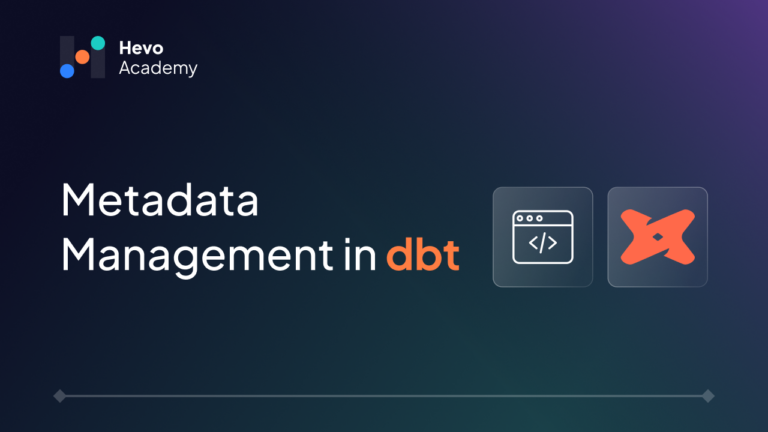Ensuring data quality and keeping track of your data’s origin and transformation is very important in this ever-changing data landscape. This is where Data Build Tool (dbt), a popular open-source transformation framework, comes in. However, to truly get the best of dbt, effective metadata management is crucial.
Table of Contents
In this blog, we will be discussing effective dbt metadata management, exploring its importance, key features, best practices, and the role Hevo plays in facilitating the active management of your data assets.
What is dbt?
dbt is an open-source data transformation tool that allows data teams to transform, test, and document data in their data warehouses. dbt is also a central hub for writing SQL codes in the form of models that define data transformations. It is similar to an assembly line for data, where each model performs a specific task, ultimately delivering high-quality and ready-to-analyze data. Unlike the traditional ETL (Extract, Transform, Load) tools that take care of the entire data pipeline, dbt focuses only on the transformation (T) aspect, providing data analysts and engineers with more control and flexibility over data transformation processes.
Hevo Data is the only no-code platform that simplifies metadata management across 150+ data sources to any destination. With Hevo, you can:
- Seamlessly sync historical data and manage metadata during ingestion
- Automatically map tables, columns, and metadata fields
- Transform data in-flight while enriching it with relevant metadata
Keep your data catalog accurate and up-to-date with Hevo’s seamless metadata integration. Start your 14-day free trial today and empower your team with efficient metadata management for better decision-making.
Get Started with Hevo for FreeImportance of Metadata Management
Metadata is simply data about data. It can help you understand what a data set is about and give you guidance on how to use it. For instance, the metadata of a data set could tell you what information the data set contains, when the data set was collected, who collected it, and other such information. With every click, swipe, or tap, users generate metadata when they access data, profile it, steal it, cleanse it, analyze it, move it around an organization, or integrate it with data captured from another data source.
Metadata management is the systematic approach to managing data about data. It includes the process, rules, and standards for data cataloging, lineage tracking, data quality, and governance. Done right, metadata management enables data to be easily discoverable, understandable and Trustworthy. It also helps organizations use data as a strategic asset and to comply with data governance frameworks and regulations. To understand better whether you need metadata management, read our blog on Why is Metadata Management Crucial for your Business?
How dbt Facilitates Effective Metadata Management
The real value of dbt is its ability to produce, capture, and maintain a comprehensive metadata table for every transformation, test, and data model. While dbt excels at data transformation, understanding the underlying context of your data is equally crucial.
Overview: dbt metadata management

Beyond transforming data in data warehouses and data lakes, dbt also captures rich metadata about the data it models. Depending on how you query it, dbt metadata can show you who is the owner of critical data transformation pipelines in the company, how they relate to each other, and how they have evolved.
dbt’s metadata management capabilities are grounded in its ability to provide data lineage, documentation, testing, and version control. These features help data teams trace data from start to finish, ensure data quality, and keep documentation up to date.
Top Key Features of dbt Metadata Management
Some of the significant features present within dbt that improve metadata management include:
- Data Lineage Tracking
Organizations can use this feature in dbt to track data from its source to its end-user. This feature is essential for knowing the effects of changes, debugging data problems and making sure that there is data integrity.
- Automated Documentation
Organizations using dbt have an advantage because they can develop comprehensive documentation automatically for each model, transformation, and test created. Therefore, this feature offers a comprehensive view of data workflows, making it easy for data teams to understand and maintain complex data transformations.
- Data Testing and Validation
Automating data testing can be done by dbt and this ensures accuracy and reliability in the transformation process. With this tool, we continuously carry out data validation and quality control.
- Version Control
dbt integrates seamlessly with version control systems like Git, allowing teams to manage changes in their data models, transformations, and tests. This feature is crucial for collaboration, auditability, and maintaining a single source of truth.
- Integration with Data Catalogs
dbt can integrate with various data catalogs and data governance platforms, providing a centralized view of data assets and their metadata. This integration enhances data discoverability and governance across the organization.
Best Practices for dbt Metadata Management
Although dbt has pre-built features, here are some recommended methods to improve your management of dbt metadata.
- Leveraging dbt Cloud for Metadata: This is the hosted version of dbt; dbt Cloud augments metadata management with features like data catalog and lineage visualization.
- Automating Documentation: Automate the production of your documentation so it’s always as up-to-date as your models.
- Integrating dbt with Data Catalogs: Take advantage of dbt’s ability to integrate very well with data catalog tools like Apache Atlas.
- Standardizing Naming Conventions: Make sure all models, tables, and columns are named consistently, using the same standard. This will promote clarity and simplify the understanding of metadata.
- Version Control Integration: Version control systems (such as Git) allow you to track changes to any of your models and ensure proper metadata versioning.
- Enforcing Data Quality Checks: Perform regular checks on your data to validate its quality and fix issues before they trickle down to your downstream workflows.
Enable active metadata management for your dbt assets.
Updating and managing metadata continuously is vital to reflect all the changes in the data environment. With dbt, you can enable active metadata management by taking advantage of automated documentation, data lineage tracking, and integration with data catalogs. This approach ensures that your metadata remains accurate, consistent, and valuable for data-driven decision-making.
How Hevo Manages Metadata for your Data Assets?
dbt is an excellent tool for managing metadata. However, tools like Hevo can enhance its capabilities. Hevo offers seamless integration with dbt, allowing you to centralize the view of dbt Models and Metadata: Hevo provides a centralized platform for organizations to manage and visualize their dbt models, their metadata, and data lineage.
- Automated Metadata Generation: Hevo automatically generates and collects metadata about your data sources, including table structures, column types, and data quality metrics. It stores the generated metadata in its internal repository, making it easy for organizations to access the data for analysis.
- Automated Data Lineage Tracking: Hevo automates tracking data lineage across your entire ETL pipeline, including dbt transformations. This will help your organization understand the origin of your data, identify dependencies, and assess the potential impact of changes to your data pipelines.
- Enhanced Data Quality Monitoring: Hevo offers advanced data quality monitoring capabilities, ensuring your data remains consistent and reliable throughout the entire workflow. This will help your organization maintain data integrity and ensure that data is suitable for analysis.
- Simplified Collaboration: Hevo facilitates collaboration by providing a single source of truth for your data assets and their metadata.
- Metadata Enrichment: Hevo allows organizations to enrich their metadata with additional information, such as business definitions, data ownership and compliance requirements.
You can find the list of metadata columns that Hevo generates here.
Conclusion
To maintain data quality and enable discoverability and governance in modern data environments, effective management of metadata is crucial. With features such as data lineage tracking, automated documentation, data testing, and integration with data catalogs, dbt offers a comprehensive solution for metadata management. However, Hevo’s metadata management capabilities provide a comprehensive solution for understanding, managing, and governing your data. By leveraging Hevo’s metadata capabilities, you can enhance data quality, govern data effectively, and gain valuable insights from your data assets.
Schedule a personalized demo to straighten your data integration.
Frequently Asked Questions
1. What is dbt used for in ETL?
Data analysts and engineers mostly use dbt for the “T” (transform) component in ETL. dbt focuses on transforming data within the data warehouse using SQL, providing data teams with greater control and flexibility over data transformations.
2. What is dbt data management?
dbt data management is the managing and transforming data within a data warehouse using dbt. It includes data modelling, testing, validation, documentation, and metadata management to ensure data quality and governance.
3. What is a metadata management system?
A metadata management system is a tool or platform that systematically manages metadata, providing data lineage, governance, data quality, and discoverability across an organization.
4. Does dbt have a data catalog?
dbt does not have a built-in data catalog however, it can be integrated with popular data catalogs like Alation, Collibra, and Amundsen to provide enhanced metadata management and discoverability.
5. What is metadata used for?
Metadata provides information about data, enabling data discoverability, quality assurance, lineage tracking, and governance. It assist organizations better data-driven decisions.
6. What are the three functions of metadata?
Data Governance: Users can use this features to ensure compliance with data policies and regulations.
Data Discoverability: Users can find relevant data quickly.
Data Quality Assurance: metadata provides information on data accuracy, consistency, and reliability.







